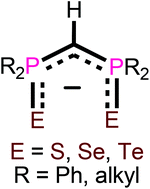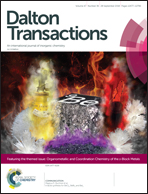s-Block metal complexes of PC(H)P-bridged chalcogen-centred methanides: comparisons with isoelectronic PNP-bridged monoanions
Abstract
The chemistry of the chalcogen-centred methanides [HC(PR2E)2]− (E = S, Se, Te; R = alkyl, aryl) (PC(H)P-bridged anions) is less well-developed than that of the isoelectronic imidodiphosphinates [N(PR2E)2]−, which are PNP-bridged analogues. The objective of this Perspective is to compare the chemistry of s-block metal complexes of the PC(H)P- and PNP-bridged anions in the context of synthetic approaches, X-ray (solid-state) structures, multinuclear NMR spectra, redox behaviour, and applications in coordination and inorganic heterocyclic chemistry. The related monochalcogeno-centred anions [HC(PR2)(PR2E)]− and [N(PR2)(PR2E)]− (E = S, Se, Te; R = alkyl, aryl) are also included in the discussion. Consideration of the similarities and, especially, the differences in the properties and reactions of the methanides with those of their imidodiphosphinate analogues reveals a number of areas in which the significance of the PC(H)P-bridged anions could be advanced.

- This article is part of the themed collections: Organometallic and coordination chemistry of the s-block metals and 2018 Frontier and Perspective articles


 Please wait while we load your content...
Please wait while we load your content...